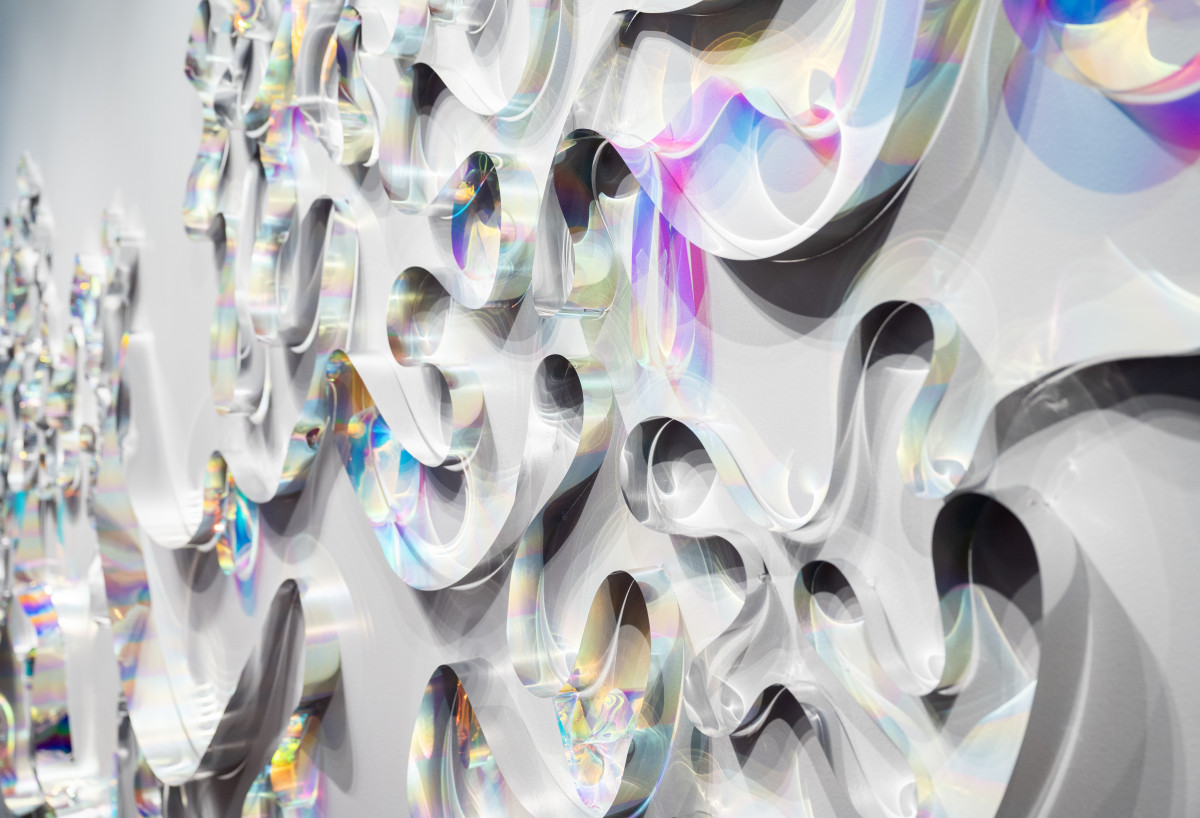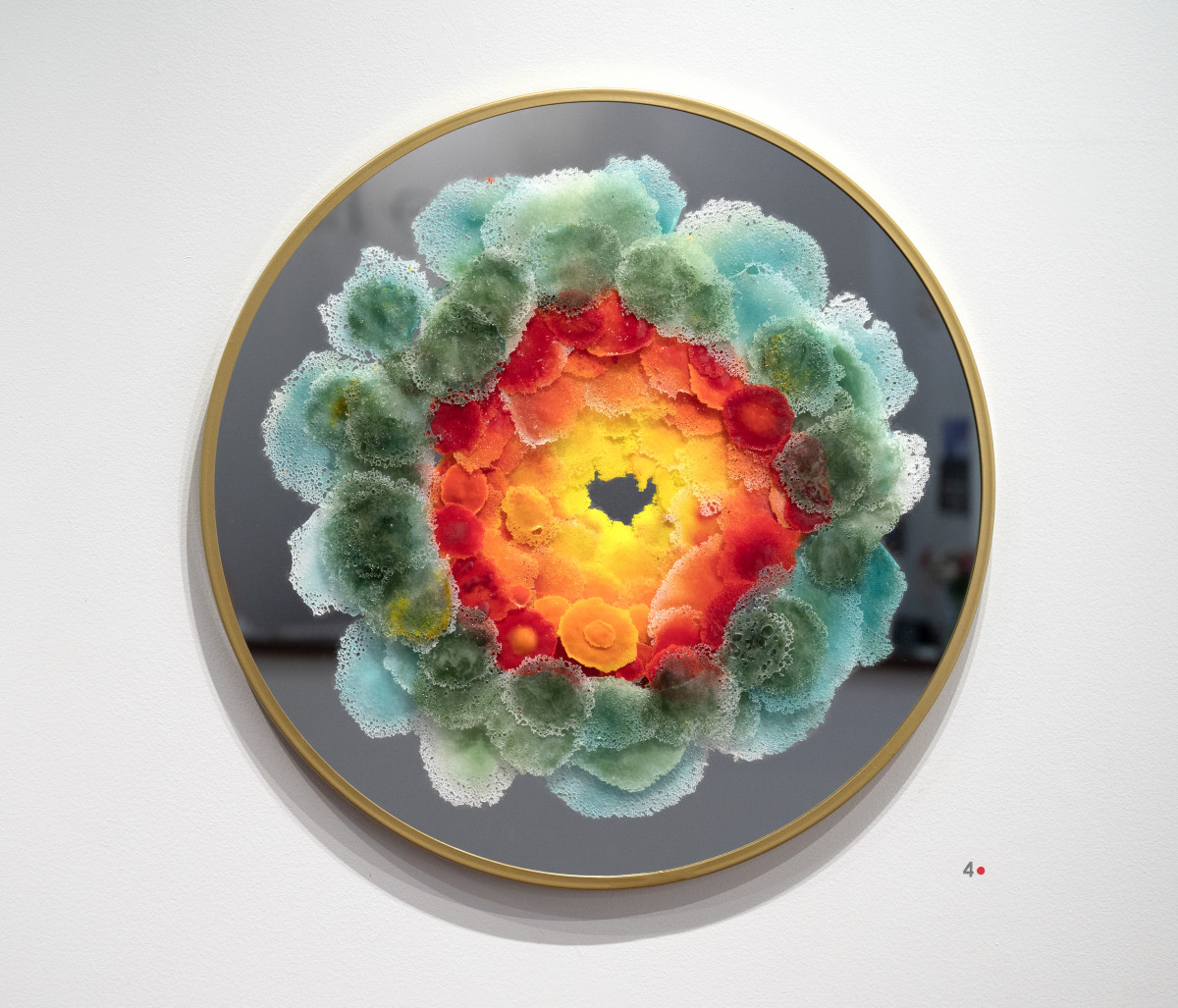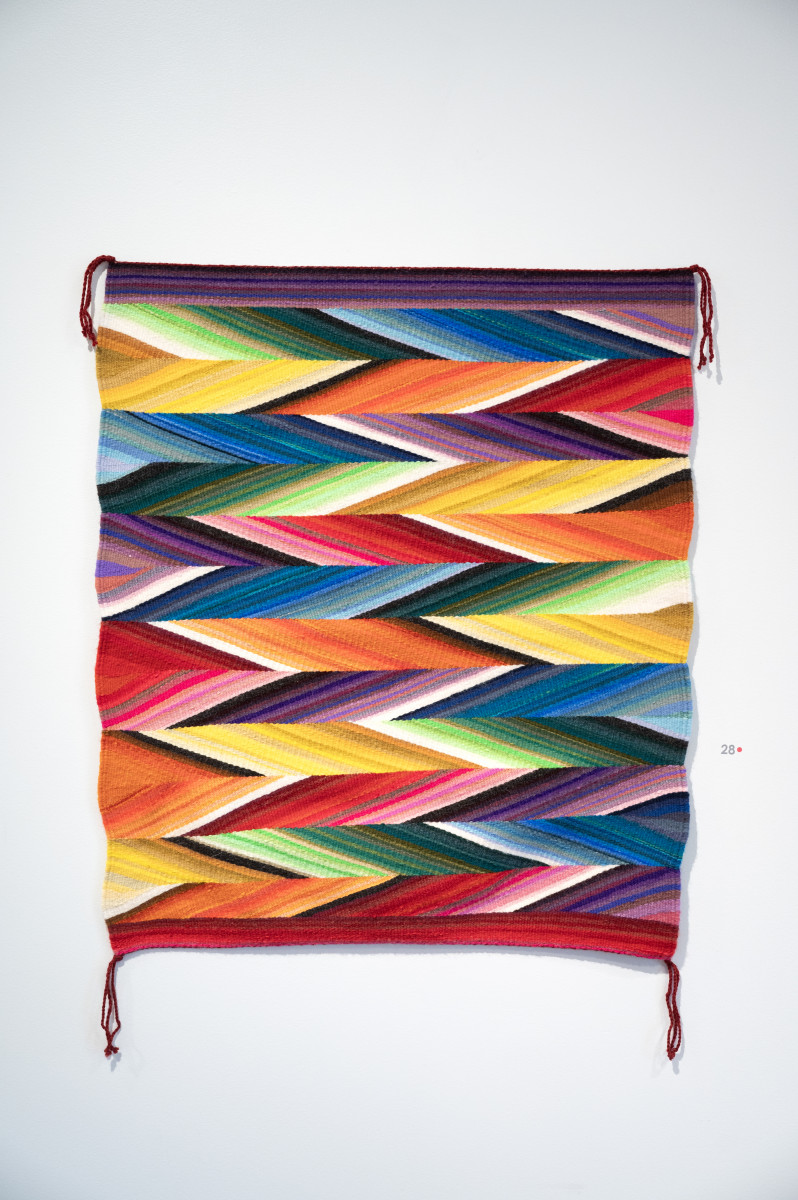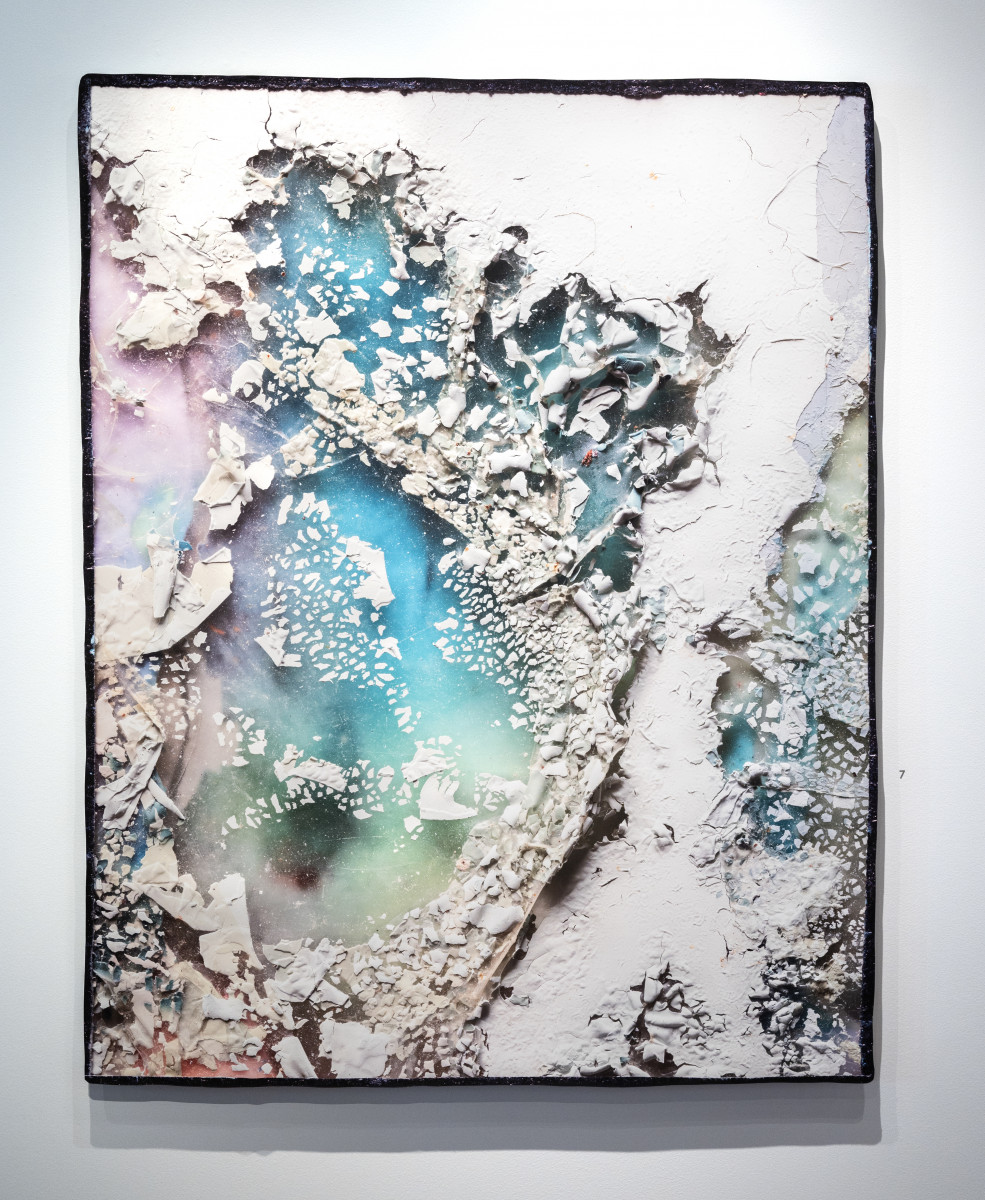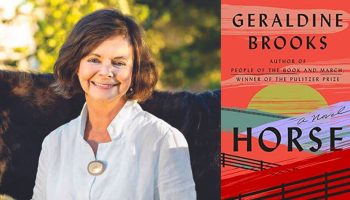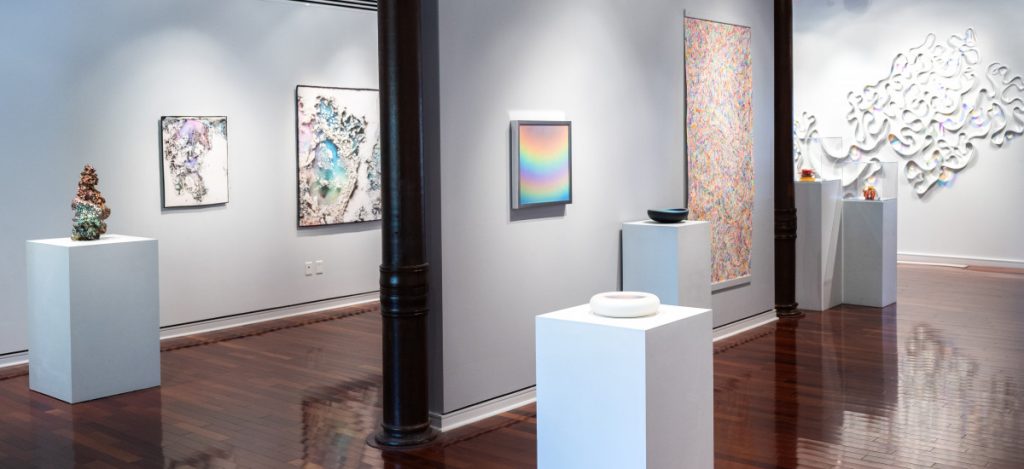
Julia Weber
Staff writer
Car headlights. Broken sunglasses. Lesbian visibility. NASA’s space-age iridescent glass.
Each of these — and more — served as inspiration to artists with pieces in Chautauqua Visual Arts’ “Prisms & Paradigms” exhibition, which is open in the Fowler-Kellogg Art Center through Wednesday.
In Fowler-Kellogg’s main gallery space, there’s a shiny and reflective arrangement of Mylar adhered to the wall. Reflecting carefully positioned lighting from its many curves and crevices, the Mylar creates deep shadows and gentle rainbows nestled within the piece.
“Prisms & Paradigms,” curated by Erika Diamond, associate director of CVA Galleries, and supported by the Kay Hardesty Logan Foundation, is an exploration of the relationships between reflection, color and light.
Across the room, in its own corner, another Mylar installation hangs from the ceiling, cascading color in every direction. It sways gently as viewers walk around it, which shifts the colors it projects.
Kazue Taguchi used found objects to create her mirrored, reflective installation pieces like her two large installations in the exhibition. Her favorite materials to create with are the ones that surprise her, like broken sunglasses, car headlights and broken cameras.
Originally inspired by the stained glass of the Notre Dame Cathedral, Taguchi has been captivated by light and reflection since she was 19 years old.
“When the sunlight hits the stained glass, it makes an abstract pattern on the floor or wall, which also moves by the sunlight (and) passing of the time,” Taguchi said.
She found herself particularly interested in the way that the imagery and color shifted based on its environment, and she eventually found herself gravitating toward the light component, rather than the medium itself.
“While making stained-glass windows over the years, I discovered I like more light than glass,” Taguchi said. “Now I use glass to create the light art installations.”
Her work carries reflectivity and color as a common theme throughout the rest of the exhibition, which plays with the light surrounding it.
Nearby, sculptural pieces engage in their own conversations with the environment around them. Situated on pedestals close by are complex glass sculptures, boasting rich colors and complex, organic forms.
Guillermo Casteñada’s glass sculptural pieces use a technique in which powdered glass and powdered plaster are layered in a mold then fused together. For Casteñada, the process is important because it reduces waste.
“Moving forward, we need to be more cautious of our waste and more mindful about our relationship to mother Earth. It is our responsibility as creators to think critically of our processes,” he wrote in his description.
Casteñada said he hopes to “enrich the world with insight and perspective that allows for communal understanding and growth.”
Julia Kunin’s ceramic sculptures also rest atop pedestals, illuminated by soft gallery lighting. Her pieces, glazed with luster, seem to change with every step taken. Kunin is heavily inspired by Art Nouveau lustreware and queer identity.
“The rainbow, glitter, glitz on the border of kitsch has a queerness to it,” Kunin said. “I’ve made work that’s been specifically about lesbian visibility, and used these luster glazes with it intentionally. … I love making things that are on the edge of kitsch.” They’re almost terrible, but not quite. It can go from elegant, to treasure, to ‘Oh my God, that’s too much.’ ”
Kunin has heavily experimented with her glazing processes throughout her career, and she’s interested in the texture that luster captures, as well as its ever-changing appearance as it engages with the light of the gallery.
“It’s really about interaction — it’s very interactive,” she said.
Venancio Aragon’s weavings are also interspersed through the space, bringing vibrant, detailed collections of color into the gallery space. His process was the focus of a talk June 26 in Hultquist Center, as part of the CVA Visiting Artist Series.
Aragon focuses on carrying his ancestors’ weaving techniques forward with him, using them in his own art as a way of preserving his heritage and paying homage to those before him.
“My relationship to my loom is not just me personally; it’s memory and history and the culture of my people and our religious philosophies all interconnected and interwoven within the textile art process for us Navajo people,” he said. Weaving helps him feel a profound connection with his culture and family, he said, and gives him “great joy and pleasure to do.”
As a child, Aragon was given a simple weaving project in school. His mother, who grew up weaving, offered to show him how to make a design. Aragon’s grandmother was a weaver and after her passing, her toolkit was dispersed to her children.
“My mom and I went around and she asked them if we could have those tools back so we could teach me,” he said. “So, all my aunts, from the backs of their closets and in dresser drawers and from wherever, these tools were reassembled and we reassembled my grandmother’s toolkit, and that’s how my mom began to teach me.”
His story as an Indigenous artisan is not an “unbroken line of continuity,” he said. “It’s a story of revival and bringing back something that was nearly lost within my family.”
While all of the artists in “Prisms & Paradigms” explore light, color and reflection, the outcomes of their experiments vary wildly.
Jon Verney uses photographs in his work, though not in a way that one might expect. He takes found photographs and cooks them on a hot plate, which causes them to tear apart. He further alters them and rephotographs them in order to produce the final image.
His pieces line the walls of the gallery. Most are still photographs, with the exception of one collaborative video piece done by Verney and Masaya Ozaki titled “I know I’ll never know.”
“In this way, these dioramas of old chemistry become conduits for expressive energy and movement, emoting larger natural systems of geologic and cosmic change,” Verney writes in his description of the photographs.
Katherine Gray’s otherworldly blown glass creations use space-age techniques to explore the depth of color.
She’s particularly interested in the duality of the iridescent effect because dichroic glass was initially developed by NASA, but looks strikingly similar to ancient glass that is recovered and preserved.
“I like how it transcends both ends of the glassmaking spectrum, from the earliest, crudest things to the most high-tech and advanced scientific applications,” she said.
From afar, the color variations are subtle and unobtrusive, but still distinctive and vibrant. Up close, though, the pigments shift dramatically with the lighting, bringing out rich blue and purple shades.
While the artists of this exhibition are inspired by different things and produce very different works, their exploration of light and color draws them together for an exploratory collection of boundary-pushing work.


